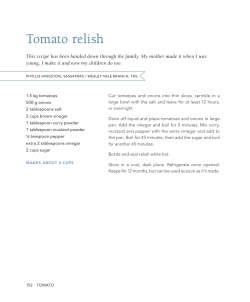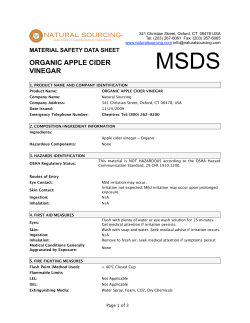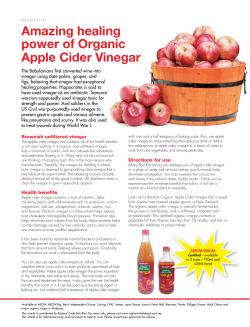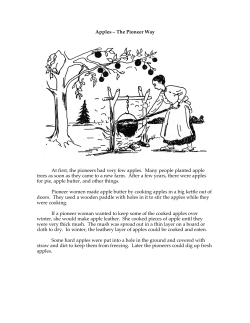
Uses of Vinegar
Uses of Vinegar HOUSEHOLD HINTS FLOORS No-wax floors: To wash no-wax floors, add ½ cup of white distilled vinegar to a half-gallon of warm water. Carpet stain removal: A mixture of 1 teaspoon of liquid detergent and 1 teaspoon of white distilled vinegar in a pint of lukewarm water will remove non-oily stains from carpets. Apply it to the stain with a soft brush or towel and rub gently. Rinse with a towel moistened with clean water and blot dry. Repeat this procedure until the stain is gone. Then dry quickly, using a fan or hair dryer. This should be done as soon as the stain is discovered. WINDOWS & WALLS Streakless windows: Simply wash with a mixture of equal parts of white distilled vinegar and warm water. Dry with a soft cloth. This solution will make your windows gleam and will not leave the usual film or streaks on the glass. Washing woodwork: You can ease the job of washing painted walls, woodwork and Venetian blinds by using a mixture of 1 cup ammonia, ½ cup white distilled or cider vinegar and ¼ cup baking soda with 1 gallon of warm water. Wipe this solution over walls or blinds with a sponge or cloth and rinse with clear water. Dirt and grime comes off easily and the solution will not dull the painted finish or leave streaks. Water or alcohol marks on wood: Stubborn rings resulting from wet glasses being placed on wood furniture may be removed by rubbing with a mixture of equal parts of white distilled vinegar and olive oil. Rub with the grain and polish for the best results. KITCHEN Garbage disposal cleaner: Garbage disposals may be kept clean and odor free with vinegar cubes. Vinegar cubes are made by filling an ice tray with a mixture of 1 cup of vinegar and enough water to fill the ice tray and then freezing it. Run the mixture through the disposal, and then flush it with cold water for a minute or so. Coffee maker cleaner (automatic): White distilled vinegar can help to dissolve mineral deposits that collect in automatic drip coffee makers from hard water. Fill the reservoir with white distilled vinegar and run it through a brewing cycle. Rinse thoroughly with water when the cycle is finished. (Be sure to check the owner’s manual for specific instructions.) Clean the microwave: Boil a solution of 1/4 cup of white distilled vinegar and 1 cup of water in the microwave. Will loosen splattered on food and deodorize. Deodorize the kitchen drain: Pour a cup of white distilled vinegar down the drain once a week. Let stand 30 minutes and then flush with cold water. Clean the refrigerator: Wash with a solution of equal parts water and white distilled vinegar. Clean and disinfect wood cutting boards: Wipe with full strength white distilled vinegar. Brass polish: Brass, copper and pewter will shine if cleaned with the following mixture. Dissolve 1 teaspoon of salt in 1 cup of white distilled vinegar and stir in flour until it becomes a paste. Apply paste to the metals and let it stand for about 15 minutes. Rinse with clean warm water and polish until dry. Ant deterrent: Ant invasions can sometimes be deterred by washing counter tops, cabinets and floors with white distilled vinegar. Getting rid of fruit flies/gnats in your kitchen: Place a bowl filled with ½ quart water, 2 Tbsp. sugar, 2 Tbsp. apple cider vinegar and a couple of drops of dish soap to attract the fruit flies. Always eliminate the source of attraction, i.e., ripened produce. Cleaning stainless steel appliances: Apply vinegar with a soft cloth to remove streaks from stainless steel appliances. Try in an inconspicuous place first. Cleaner dishes and glasses: Pour 1 ½ cup to 2 cups white distilled vinegar in the bottom of dishwasher, along with regular dishwasher soap. Wash full cycle. Remove refrigerator smells: Place 1 cup apple cider vinegar in a glass and set in refrigerator. Within 2 days, any smell is gone! BATHROOM Bathtub film: Bathtub film can be removed by wiping with white distilled vinegar and then with soda. Rinse clean with water. Shower doors: Rub down shower doors with a sponge soaked in white distilled vinegar to remove soap residue. Toilet bowl cleaner: Stubborn stains can be removed from the toilet by spraying them with white distilled vinegar and brushing vigorously. The bowl may be deodorized by adding 3 cups of white distilled vinegar. Allow it to remain for a half hour, then flush. Unclog the showerhead: Corrosion may be removed from showerheads or faucets by soaking them in white distilled vinegar overnight. This may be easily accomplished by saturating a terry cloth towel in vinegar and wrapping it around the showerhead or faucet. LAWN/GARDEN Kill grass: To kill grass on sidewalks and driveways, pour full strength white distilled vinegar on it. Kill weeds: Spray white distilled vinegar full strength on tops of weeds. Reapply on any new growth until plants have starved. Increase soil acidity: In hard water areas, add a cup of vinegar to a gallon of tap water for watering acid loving plants like rhododendrons, gardenias or azaleas. The vinegar will release iron in the soil for the plants to use. Neutralize garden lime: Rinse your hands liberally with white distilled vinegar after working with garden lime to avoid rough and flaking skin. Clean pots before repotting, rinse with vinegar to remove excess lime. Keep flowers longer: Keep flowers fresh longer. Add 2 tablespoons sugar and 2 tablespoons white vinegar in a 1-quart vase of water. Trim stems and change water every five days. Plant nutrients: Mix vinegar and water in a ratio of 1:8. Mix a separate solution of sugar and water in a mixture of 1:8. Combine the vinegar and sugar mixtures. Add to plant as long as needed. PETS Pest fighter: A teaspoon of white distilled vinegar for each quart bowl of drinking water helps keep your pet free of fleas and ticks. The ratio of one teaspoon to one quart is for a 40-pound animal. Pet accident: Test the color fastness of the carpet with white distilled vinegar in an inconspicuous place. Then sprinkle distilled vinegar over the fresh pet accident. Wait a few minutes and sponge from the center outward. Blot up with a dry cloth. This procedure may need to be repeated for stubborn stains. Get rid of odor on a smelly dog: Wet the dog down with fresh water. Use a mixture of 1 cup white distilled vinegar and 2 gallons water. Saturate the dog’s coat with this solution. Dry the dog off without rinsing the solution. The smell will be gone! OTHER Bumper stickers: Remove bumper stickers by repeatedly wiping the sticker with white distilled vinegar until it is soaked. In a few minutes, it should peel off easily. Test on a small invisible area of the car to ensure there will be no damage to the paint. Paintbrush softener: Soak the paintbrush in hot white distilled vinegar, and then wash out with warm, sudsy water. Cleaning the radiator vent: Turn down the thermostat. Unscrew the air vent, soak it in vinegar to clean it, then turn the thermostat all the way up. After a few minutes, you'll hear a hissing sound followed by a little bit of water spurting out. Finally, steam will start exiting that hole. Turn off the radiator valve and replace the vent. It should be straight up and hand tight. You should not need or use a wrench. Frosted windows: For those rare winter mornings when there is frost on the car, wipe the windows the night before with a solution of one part water to three parts white distilled vinegar. They won’t frost over. Furniture: Mix olive oil and vinegar in a one-to-one ratio and polish with a soft cloth. Try in an inconspicuous place first. Cleaning leather shoes: Make a solution of one part water to one part white vinegar, and use it sparingly on the shoes. Dip a cloth into the solution, and dab it over the salt-streaked parts of your shoes. May have to repeat the cleaning a few times before all the salt is removed. Salt actually can damage leather, so it's best to clean shoes as quickly as possible. Don't let the salt stains build up. Fireplaces: Wash fireplaces with a 50/50 ratio of water and vinegar to remove the blackened soot on glass front doors. If the doors have a spring-loaded clip, remove it, then take out the doors. Lay them flat on newspapers, spray with the vinegar/water solution and soak. Wipe it off with newspaper. Cleaner for gold jewelry (Winner of June 2007 vinegar online use contest): Use one cup apple cider vinegar. Submerge solid gold jewelry item in vinegar for 15 minutes. Remove and dry with cloth. Remove lime stains from car: Pour a small amount of white vinegar on a clean cloth. Gently rub the area of lime staining with the cloth until the stain is gone. Test a small area first to ensure no discoloration. Worn DVDs: If you have a worn DVD that has begun to stick or suffers from the occasional freeze-frame, wipe it down with white distilled vinegar applied to a soft cloth. Ensure the DVD is completely dry before re-inserting in the DVD player. (Note: This only works on DVDs that are scratched or dirty through normal wear.) LAUNDRY HINTS Wine stains: Spots caused by wine can be removed from 100 percent cotton, cotton polyester and permanent press fabrics if done so within 24 hours. To do it, sponge white distilled vinegar directly onto the stain and rub away the spots. Then clean according to the directions on the manufacturer's care tag. Freshen baby clothes: The addition of 1 cup of white distilled vinegar to each load of baby clothes during the rinse cycle will naturally break down uric acid and soapy residue leaving the clothes soft and fresh. Clothes washing magic: Clothes will rinse better if 1 cup of white distilled vinegar is added to the last rinse water. The acid in vinegar is too mild to harm fabrics, but strong enough to dissolve the alkalies in soaps and detergents. Blanket renewal: Cotton and wool blankets become soft, fluffy and free of soap odor if 2 cups of white distilled vinegar are added to the rinse cycle of the wash. Deodorant stains: Deodorant and antiperspirant stains may be removed from clothing by lightly rubbing with white distilled vinegar and laundering as usual. Hole removal: After a hem or seam is removed, there are often unsightly holes left in the fabric. These holes can be removed by placing a cloth moistened with white distilled vinegar under the fabric and ironing. Keeping colors fast: To hold colors in fabrics that tend to run, soak them for a few minutes in white distilled vinegar before washing. Leather cleaning: Leather articles can be cleaned with a mixture of white distilled vinegar and linseed oil. Rub the mixture into the leather and then polish with a soft cloth. Scorch marks: Lightly rub white distilled vinegar on fabric that has been slightly scorched. Wipe with a clean cloth. Setting colors: When you are color dyeing, add about a cupful of white distilled vinegar to the last rinse water to help set the color. Shower curtains: Add 1 cup of white distilled vinegar to the rinse water when you launder your shower curtain. Do not spin dry or wash out. Just hang immediately to dry. Unclog steam iron: Pour equal amounts of white distilled vinegar and water into the iron's water chamber. Turn to steam and leave the iron on for 5 minutes in an upright position. Then unplug and allow to cool. Any loose particles should come out when you empty the water. Clean a scorched iron plate: Heat equal parts white distilled vinegar and salt in a small pan. Rub solution on the cooled iron surface to remove dark or burned stains. Cleaning vintage lace: Soak the lace in cold water, rinsing it several times. Next, hand-wash the lace gently with a wool detergent, such as Woolite. If rust spots are a problem, try removing them with a mixture of white vinegar and hot water. FOOD PREPARATION Getting the last drops: When you can’t get the last bit of mayonnaise or salad dressing out of the jar, try dribbling a little of your favorite vinegar into it, put the cap on tightly and shake well. You’ll be amazed at how much you’ve been wasting. Cooking fish: Try soaking fish in vinegar and water before cooking it. It will be sweeter, more tender and hold its shape better. When boiling or poaching fish, a tablespoon of vinegar added to the water will keep it from crumbling so easily. Cake icing: Cake icing can be prevented from becoming sugary if a little vinegar is added to the ingredients before cooking. The same is true when making homemade candy. Boiling eggs: When boiling an egg and it’s cracked, a little vinegar in the water will keep the white from running out. Keeping potatoes white: A teaspoon of white distilled or cider vinegar added to the water in which you boil potatoes will keep them nice and white. You can keep peeled potatoes from turning dark by covering them with water and adding 2 teaspoons of vinegar. Freshen vegetables: Freshen up slightly wilted vegetables by soaking them in cold water and vinegar. Fruit and vegetable wash: Add 2 tablespoons white distilled vinegar to 1 pint water and use to wash fresh fruits and vegetables, then rinse thoroughly. Research has shown that vinegar helps kill bacteria on fruits and vegetables. Frying doughnuts: Before frying doughnuts, add ½ teaspoon of vinegar to hot oil to prevent doughnuts soaking up extra grease. Use caution when adding the vinegar to the hot oil. Flavor booster: Perk up a can of soup, gravy or sauce with a teaspoon of your favorite specialty vinegar. It adds flavor and taster fresher. Meat tenderizer: As a tenderizer for tough meat or game, make a marinade in the proportion of half a cup of your favorite vinegar to a cup of heated liquid, such as bouillon; or for steak, you may prefer to a mix of vinegar and oil, rubbed in well and allowed to stand for two hours. Fruit stains: Remove fruit or berry stains from your hands by cleaning them with vinegar. Fresh lunch box: It is easy to take out the heavy stale smell often found in lunch boxes. Dampen a piece of fresh bread with white distilled vinegar and leave it in the lunch box overnight. Get rid of cooking smells: Let simmer a small pot of vinegar and water solution. Fluffy egg whites: Soak a paper towel with 1-2 tablespoons of white distilled vinegar. Wipe mixing bowl and beaters or whisk with the vinegar-soaked paper towel, then dry with a cloth or paper towel prior to whipping egg whites. Fluffier rice: For fluffier and great tasting rice, add a teaspoon of white distilled vinegar to the boiling water before adding rice. Rice will be easier to spoon and less sticky. HEALTH Continuous Positive Airway Pressure (CPAP) Machine for Sleep Apnea: To clean the calcium deposit of the humidifier reservoir, heat 450 ml (1¾ cups) of vinegar in the microwave for 2 minutes. Pour vinegar into reservoir and replace cap. Let sit for 1 hour. Remove vinegar. Reservoir should be clean and calcium free. Contact manufacturer before cleaning with this method or review manufacturer’s directions. Soothe a bee or jellyfish sting: Douse with vinegar. It will soothe irritation and relieve itching. Relieve sunburn: Lightly rub white distilled or cider vinegar on skin. Reapply as needed. Relieve dry and itchy skin: Add 2 tablespoons of vinegar to your bath water. Fight dandruff: After shampooing, rinse with a solution of ½ cup vinegar and 2 cups of warm water. Soothe a sore throat: Put a teaspoon of vinegar in a glass of water. Gargle, then swallow. For another great gargle: 1 cup hot water, 2 tablespoons honey, 1 teaspoon vinegar, gargle then drink. Treat sinus infections and chest colds: Add 1/4 cup or more vinegar to the vaporizer. (Be sure to check vaporizer instructions for additional water measurement.) Skin burns: Apply ice-cold vinegar right away for fast relief. Will prevent burn blisters. Chest congestion: To clear up respiratory congestion, inhale a vapor mist from steaming pot containing water and several spoonfuls of vinegar. Toenail fungus: Soak toes in a solution of vinegar and water, using 1 part vinegar to 2 parts water, 15 minutes per day. Arthritis relief: Mix a teaspoon of half apple cider vinegar, half honey in a glass of water with a teaspoon of orange flavored Knox gelatin. Lessen morning sickness: Drink some apple cider vinegar in water, with honey added. This concoction can help calm a queasy stomach. Stop Itching: Apply a paste made from vinegar and cornstarch. Keep on until itch disappears. Cleaning heavily soiled hands: Moisten cornmeal with apple cider vinegar. Scrub hands, rinse in cold water and pat dry. Soft feet: Combine 1 cup white distilled vinegar to 2 gallons warm water. Soak feet for 45 minutes, then use a pumice stone or file to remove dead skin from heels and callused areas of feet. Wart remover: Mix lukewarm/warm water with a cup of white distilled vinegar. Immerse area with wart and soak 20 minutes every day until wart disappears. Bug spray: Combine equal amounts of water, white distilled vinegar and liquid dish soap in a spray bottle. Use on skin, as needed. KIDS STUFF Coloring Easter eggs: Mix 1 teaspoon of vinegar with each ½ cup of hot water, then add food coloring. (Check egg-coloring booklets or food dye box for specific directions.) Vinegar keeps the food dyes bright and prevents streaky, uneven colors. Making naked eggs: Place eggs in a container so the eggs are not touching. Add enough vinegar to cover the eggs. Cover the container, put in the refrigerator and let the eggs sit in the vinegar for 24 hours. Use a large spoon to scoop the eggs out of the container. Be careful since the eggshell has been dissolving, the egg membrane may be the only thing holding the egg together. Carefully dump out the vinegar. Put the eggs back in the container and cover them with fresh vinegar. Leave the eggs in the refrigerator for another 24 hours. Scoop the eggs out again and rinse them carefully. If any of the membranes have broken, throw those eggs away. When you’re done, you’ll have an egg without a shell. How to build a volcano: First, make the “cone” of the volcano. Mix 6 cups flour, 2 cups salt, 4 tablespoons cooking oil and 2 cups of water. The resulting mixture should be smooth and firm (more water may be added if needed). Stand a soda bottle in a baking pan and mold the dough around it into a volcano shape. Do not cover the hole or drop dough into it. Fill the bottle most of the way full with warm water and a bit of red food color (can be done before sculpting if you do not take so long that the water gets cold). Add 6 drops of detergent to the bottle contents. Add 2 tablespoons baking soda to the liquid. Slowly pour vinegar into the bottle. Watch out – eruption time! BERRY INK & QUILL PENS Berry ink ingredients: ½ cup ripe berries (blueberries, cherries, blackberries, strawberries, elderberries, raspberries, etc.); ½ Tsp. Vinegar; ½ Tsp. Salt Fill a strainer with the berries and hold it over a bowl. Using the rounded back of a wooden spoon, crush the berries against the strainer so that the berry juice strains into the bowl. Keep adding berries until most of their juice has been strained out and only pulp remains. Add the salt and vinegar to the berry juice. The vinegar helps the ink retain its color and the salt keeps it from getting too moldy. If the berry ink is too thick, add a tablespoon of water. Store in a baby food jar. Only make a small amount of berry ink at a time and, when not in use, keep it tightly covered. Quill pen ingredients: A large feather (find your own or purchase one from a craft store) Craft knife Paper Berry ink Paper towels Use a craft knife to cut the tip of the feather at an angle. Carefully, cut a slit in the tip. Dip the feather into the berry ink. Dab the end on a paper towel. Repeat as needed. Now, write your masterpiece just like the pioneers did! (from The Vinegar Institute, www.versatilevinegar.org/useandtips.html)
© Copyright 2025








